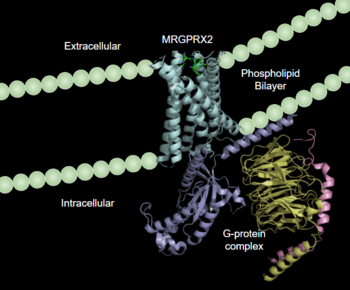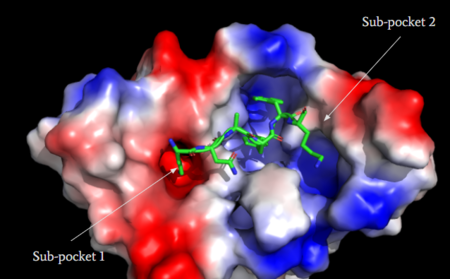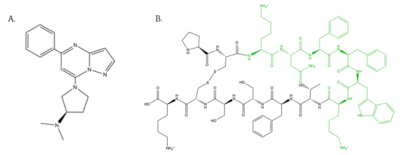Sandbox Reserved 1723
From Proteopedia
(Difference between revisions)
| Line 7: | Line 7: | ||
== G-Protein Coupled Receptors == | == G-Protein Coupled Receptors == | ||
| - | [https://proteopedia.org/wiki/index.php/G_protein-coupled_receptors G-protein coupled receptors](GCPRs) are a large family of cell surface membrane receptors. Once bound to a wide variety of extracellular ligands, GCPRs undergo a conformational change and relay information to intracellular secondary messengers <ref name="Thal">Thal, David M., et al. "Structural insights into G-protein-coupled receptor allostery." Nature, Nature Publishing Group, 04 July 2018, https://www.nature.com/articles/s41586-018-0259-z</ref>. This G protein activation results in a cellular response dependent on the ligand bound and location of the GPCR in the body. GCPRs can be broken down into five families: the rhodopsin family (class A), the secretin family (class B), the adhesion family, the glutamate family (class C), and the frizzled/taste family (class F) <ref name="Zhang">PMID: 26467290</ref>. All of the families have a similar transmembrane (TM) domain consisting of seven <scene name='90/904328/7tm_domain_pt_3/7'>α-helices</scene> complexed with intracellular G proteins. | + | [https://proteopedia.org/wiki/index.php/G_protein-coupled_receptors G-protein coupled receptors](GCPRs) are a large family of cell surface membrane receptors. Once bound to a wide variety of extracellular ligands, GCPRs undergo a conformational change and relay information to intracellular secondary messengers <ref name="Thal">Thal, David M., et al. "Structural insights into G-protein-coupled receptor allostery." Nature, Nature Publishing Group, 04 July 2018, https://www.nature.com/articles/s41586-018-0259-z</ref>. This G protein activation results in a cellular response dependent on the ligand bound and location of the GPCR in the body. GCPRs can be broken down into five families: the [https://en.wikipedia.org/wiki/Rhodopsin-like_receptors rhodopsin family (class A)], the [https://en.wikipedia.org/wiki/Secretin_receptor_family secretin family (class B)], the [https://en.wikipedia.org/wiki/Adhesion_G_protein-coupled_receptor adhesion family], the [https://en.wikipedia.org/wiki/Class_C_GPCR glutamate family (class C)], and the frizzled/taste family (class F) <ref name="Zhang">PMID: 26467290</ref>. All of the families have a similar transmembrane (TM) domain consisting of seven <scene name='90/904328/7tm_domain_pt_3/7'>α-helices</scene> complexed with intracellular G proteins. |
=== Class A GCPRs === | === Class A GCPRs === | ||
| Line 21: | Line 21: | ||
==== ''Toggle Switch'' ==== | ==== ''Toggle Switch'' ==== | ||
| - | In β2AR, and other Class A GPCRs, a “toggle switch” of <scene name='90/ | + | In β2AR, and other Class A GPCRs, a “toggle switch” of <scene name='90/904327/B2artoggleswitchyes/5'>Trp-286</scene> which limits the proximity of the TM helices as tryptophan sterically occludes tight interaction. This results in a deep binding pocket for ligand binding. In contrast, in MRGPRX2 Trp-286 is replaced by <scene name='90/904328/Toggle_switch_gly_pt_2/1'>Gly-236</scene> <ref name="Cao"/> <ref name="Yang"/>. Glycine is a much smaller amino acid and thus allows the helices to close the base of the binding pocket. This causes MRGPRX2 to have a much shallower binding site and allows more promiscuous ligand binding. This can be seen in a shorter distance from the toggle switch to the ligand in β2AR compared to MRGPRX2. |
==== ''Disulfide bonds'' ==== | ==== ''Disulfide bonds'' ==== | ||
| Line 40: | Line 40: | ||
== Binding Pocket == | == Binding Pocket == | ||
| + | MRGPRX2 consists of two binding pockets (seen in Figure 2). Sub-pocket 1 consists of primarily hydrophobic aromatic residues; Phe-170, Trp-243, and Phe-244.<ref name="Yang">Yang, Fan, et al. "Structure, function and pharmacology of human itch receptor complexes." Nature, Nature Publishing Group, 17 November 2021, https://www.nature.com/articles/s41586-021-04077-y</ref> These residues provide stabilization with ligands through stacking. This pocket also contains acidic catalytic residues Asp-184 and Glu-164 that interact with substrates by making ion pairs. Lastly, this pocket is in close proximity with the commonly conserved disulfide bond (formed by Cys-168 and Cys-180) seen in most Class A GPCRs. The second binding pocket forms electrostatic interactions with larger substrates (seen in Figure 2), but is generally less studied.<ref name="Cao"/> | ||
| - | + | [[Image:Electro.PNG|450px|center|thumb|'''Figure 2''': Binding pocket of MRGPRX2 with cortistatin-14. Two different binding pockets are present in MRGPRX2 and cortistatin-14 interacts with both of them. <ref name="Cao"/>]] | |
| - | [[Image:Electro.PNG|350px|center|thumb|'''Figure 2''': Binding pocket of MRGPRX2 with cortistatin-14. Two different binding pockets are present in MRGPRX2 and cortistatin-14 interacts with both of them. <ref name="Cao"/>]] | ||
==== Agonists ==== | ==== Agonists ==== | ||
| + | [[Image:Agoniststogether.PNG |400px|right|thumb|'''Figure 3''': Structure of MRGPRX2 Agonists. (A) Structure of R-Zinc 3573. A cationic ligand selected for binding to MRGPRX2.<ref name="Yang">Yang, Fan, et al. "Structure, function and pharmacology of human itch receptor complexes." Nature, Nature Publishing Group, 17 November 2021, https://www.nature.com/articles/s41586-021-04077-y</ref> (B) Structure of Cortistatin-14 with resolved amino acids highlighted in green. These ligands were used as a probes for MRGPRX2 function and stabilization for structure determination.<ref name="Yang">Yang, Fan, et al. "Structure, function and pharmacology of human itch receptor complexes." Nature, Nature Publishing Group, 17 November 2021, https://www.nature.com/articles/s41586-021-04077-y</ref>]] | ||
===== Cation ===== | ===== Cation ===== | ||
| Line 55: | Line 56: | ||
<scene name='90/904328/Overview_x2_c_pt_3/4'>Cortistatin-14</scene> is one of the peptide ligands that binds to MRGPRX2. Cortistatin-14 interacts with the binding pocket through an <scene name='90/904328/Zic14_pt_3/4'>electrostatic</scene> interaction in sub-pocket 1 between Lys-3 on the peptide and Glu-164 and Asp-184 on MRGPRX2 <ref name="Cao"/>. Additionally, there are hydrophobic interactions in sub-pocket 2 between the peptide and the binding pocket due to the large hydrophobic amino acids on Cortistatin-14. | <scene name='90/904328/Overview_x2_c_pt_3/4'>Cortistatin-14</scene> is one of the peptide ligands that binds to MRGPRX2. Cortistatin-14 interacts with the binding pocket through an <scene name='90/904328/Zic14_pt_3/4'>electrostatic</scene> interaction in sub-pocket 1 between Lys-3 on the peptide and Glu-164 and Asp-184 on MRGPRX2 <ref name="Cao"/>. Additionally, there are hydrophobic interactions in sub-pocket 2 between the peptide and the binding pocket due to the large hydrophobic amino acids on Cortistatin-14. | ||
| - | + | ||
== MRGPRX2 Signaling Pathway == | == MRGPRX2 Signaling Pathway == | ||
| + | === 1.Substrate Binding=== | ||
| + | |||
| + | === 2. MRGPRX2 interaction with G-Protein=== | ||
| + | MRGPRX2 interacts with two different types of G-proteins, Gi and Gq. When activated these G-proteins will initiate the signal transduction pathway. These G-proteins are composed of 3 subunits; α, β, and γ. | ||
| + | |||
| + | === 3.After G-Protein Activation=== | ||
MRGPRX2 mediates degranulation of mast cells through interaction with Gq and Gi subunits. Gq activation signals through [https://en.wikipedia.org/wiki/Phospholipase_C Phospholipase C], which catalyzes the cleavage of Phosphatidylinositol bisphosphate into [https://en.wikipedia.org/wiki/Diglyceride diacylglycerol (DAG)] and [https://en.wikipedia.org/wiki/Inositol_trisphosphate inositol trisphosphate (IP3)]. DAG is then able to increase the activity of [https://en.wikipedia.org/wiki/Protein_kinase_C protein kinase C]. IP3 receptor is ligand gated calcium channel on the endoplasmic reticulum (ER), that causes the release of calcium in cytoplasm. Subsequently, this results in muscle contraction and enzyme activation. | MRGPRX2 mediates degranulation of mast cells through interaction with Gq and Gi subunits. Gq activation signals through [https://en.wikipedia.org/wiki/Phospholipase_C Phospholipase C], which catalyzes the cleavage of Phosphatidylinositol bisphosphate into [https://en.wikipedia.org/wiki/Diglyceride diacylglycerol (DAG)] and [https://en.wikipedia.org/wiki/Inositol_trisphosphate inositol trisphosphate (IP3)]. DAG is then able to increase the activity of [https://en.wikipedia.org/wiki/Protein_kinase_C protein kinase C]. IP3 receptor is ligand gated calcium channel on the endoplasmic reticulum (ER), that causes the release of calcium in cytoplasm. Subsequently, this results in muscle contraction and enzyme activation. | ||
| Line 66: | Line 73: | ||
== Clinical Relevance == | == Clinical Relevance == | ||
| - | [[Image:Drugs_and_zinc.PNG| | + | [[Image:Drugs_and_zinc.PNG|450px|right|thumb|'''Figure 4''': Structures of (R)-Zinc-3573, Dextromethorphan, Morphine, and Codeine. The red circles indicate conserved basic N-dimethyl group and the blue squares show the conserved benzene rings.<ref name="Cao"/>]] |
| - | + | ||
| - | + | MRGPRX2 activation is associated with chronic itching or anaphylaxis reactions, a common side effect of many prescribed medications. <ref name="Cao"/> Among these drugs are opiods [https://en.wikipedia.org/wiki/Morphine morphine] and [https://en.wikipedia.org/wiki/Codeine codeine] and [https://en.wikipedia.org/wiki/Dextromethorphan dextromethorphan]. By analyzing the structures of these drugs, it can be seen that they contain chemical features similar to agonist R-Zinc-3573 (see Figure 4). They contain a conserved benzene ring that stabilizes them in binding pocket one (See Figure 3). Similarly, they contain an N-dimethyl group that would allow them to form key bonds with residues Asp-184 and Glu-164. Lastly, these drugs have a similar shape and size to that of the agonist R-Zinc-3573.<ref name="Babina"> Babina, M., et al. "MRGPRX2 Is the Codeine Receptor of Human Skin Mast Cells: Desensitization through β-Arrestin and Lack of Correlation with the FcεRI Pathway." Journal of Investigative Dermatology, 141(6), 1286-1296. https://doi.org/10.1016/j.jid.2020.09.017</ref> These structural and chemical similarities indicate the possibility of a similar binding mechanism. | |
| + | This receptor is shallow and is able to bind to a variety of drugs, creating a need a solution to mediate the effects of MRGPRX2 activation. Currently, there is research for the development of small antagonists that will induce an anti-inflammatory effect by prevent IgE-dependet mast cell degranulation.<ref name="McNeil">McNeil, B. D., et al. "MRGPRX2 and Adverse Drug Reactions." Frontier Immunology, 06 August 2021, https://www.frontiersin.org/articles/10.3389/fimmu.2021.676354/full</ref> There are two antagonists that have been adapted from being agonists to another Class A GPCR, neurokinin-1 receptor (NK-1R).<ref name="Ogasawara">Ogasawara, H., et al. "Novel MRGPRX2 antagonists inhibit IgE-independent activation of human umbilical cord blood-derived mast cells." Journal of Leukocyte Biology, 12 July 2019, https://jlb.onlinelibrary.wiley.com/doi/10.1002/JLB.2AB1018-405R</ref> Through the development of this research, these adverse side effects can be relieved and improve patient satisfaction. | ||
Revision as of 18:06, 20 April 2022
| This Sandbox is Reserved from February 28 through September 1, 2022 for use in the course CH462 Biochemistry II taught by R. Jeremy Johnson at the Butler University, Indianapolis, USA. This reservation includes Sandbox Reserved 1700 through Sandbox Reserved 1729. |
To get started:
More help: Help:Editing |
Human Itch GPCR
| |||||||||||
References
- ↑ 1.0 1.1 1.2 1.3 1.4 1.5 1.6 1.7 Cao, Can, et al. "Structure, function and pharmacology of human itch GPCRs." Nature, Nature Publishing Group, 17 November 2021, https://www.nature.com/articles/s41586-021-04126-6
- ↑ Thal, David M., et al. "Structural insights into G-protein-coupled receptor allostery." Nature, Nature Publishing Group, 04 July 2018, https://www.nature.com/articles/s41586-018-0259-z
- ↑ 3.0 3.1 Zhang D, Zhao Q, Wu B. Structural Studies of G Protein-Coupled Receptors. Mol Cells. 2015 Oct;38(10):836-42. doi: 10.14348/molcells.2015.0263. Epub 2015, Oct 15. PMID:26467290 doi:http://dx.doi.org/10.14348/molcells.2015.0263
- ↑ 4.0 4.1 4.2 Zhou Q, Yang D, Wu M, Guo Y, Guo W, Zhong L, Cai X, Dai A, Jang W, Shakhnovich EI, Liu ZJ, Stevens RC, Lambert NA, Babu MM, Wang MW, Zhao S. Common activation mechanism of class A GPCRs. Elife. 2019 Dec 19;8. pii: 50279. doi: 10.7554/eLife.50279. PMID:31855179 doi:http://dx.doi.org/10.7554/eLife.50279
- ↑ 5.0 5.1 5.2 5.3 5.4 5.5 5.6 5.7 Yang, Fan, et al. "Structure, function and pharmacology of human itch receptor complexes." Nature, Nature Publishing Group, 17 November 2021, https://www.nature.com/articles/s41586-021-04077-y
- ↑ 6.0 6.1 Schonegge, Anne-Marie, et al. "Evolutionary action and structural basis of the allosteric switch controlling β2AR functional selectivity." Nature, Nature Publishing Group, 18 December 2017, https://www.nature.com/articles/s41467-017-02257-x
- ↑ Sandoval, A., et al. "The Molecular Switching Mechanism at the Conserved D(E)RY Motif in Class-A GPCRs." Biophysical journal, 111(1), 79-89. https://doi.org/10.1016/j.bpj.2016.06.004
- ↑ Katritch V, Fenalti G, Abola EE, Roth BL, Cherezov V, Stevens RC. Allosteric sodium in class A GPCR signaling. Trends Biochem Sci. 2014 May;39(5):233-44. doi: 10.1016/j.tibs.2014.03.002. Epub , 2014 Apr 21. PMID:24767681 doi:http://dx.doi.org/10.1016/j.tibs.2014.03.002
- ↑ Babina, M., et al. "MRGPRX2 Is the Codeine Receptor of Human Skin Mast Cells: Desensitization through β-Arrestin and Lack of Correlation with the FcεRI Pathway." Journal of Investigative Dermatology, 141(6), 1286-1296. https://doi.org/10.1016/j.jid.2020.09.017
- ↑ McNeil, B. D., et al. "MRGPRX2 and Adverse Drug Reactions." Frontier Immunology, 06 August 2021, https://www.frontiersin.org/articles/10.3389/fimmu.2021.676354/full
- ↑ Ogasawara, H., et al. "Novel MRGPRX2 antagonists inhibit IgE-independent activation of human umbilical cord blood-derived mast cells." Journal of Leukocyte Biology, 12 July 2019, https://jlb.onlinelibrary.wiley.com/doi/10.1002/JLB.2AB1018-405R




